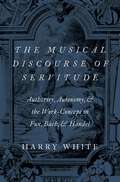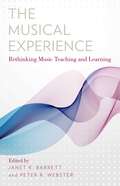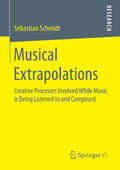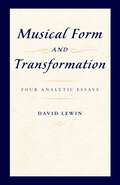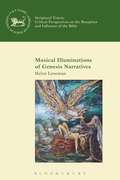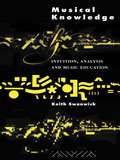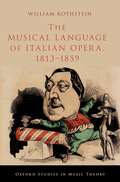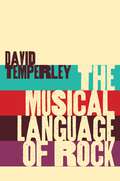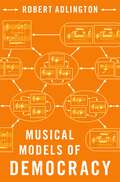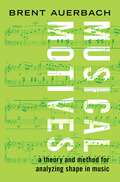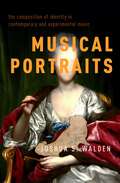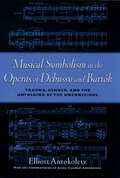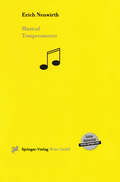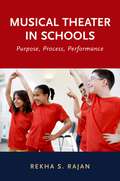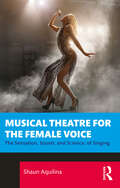- Table View
- List View
The Musical Discourse of Servitude: Authority, Autonomy, and the Work-Concept in Fux, Bach and Handel
by Harry WhiteExamining, for the first time, the compositions of Johann Joseph Fux in relation to his contemporaries Bach and Handel, The Musical Discourse of Servitude presents a new theory of the late baroque musical imagination. Author Harry White contrasts musical "servility" and "freedom" in his analysis, with Fux tied to the prevailing servitude of the day's musical imagination, particularly the hegemonic flowering of North Italian partimento method across Europe. In contrast, both Bach and Handel represented an autonomy of musical discourse, with Bach exhausting generic models in the mass and Handel inventing a new genre in the oratorio. A potent critique of Lydia Goehr's seminal The Imaginary Museum of Musical Works, The Musical Discourse of Servitude draws on Goehr's formulation of the "work-concept" as an imaginary construct which, according to Goehr, is an invention of nineteenth-century reception history. White locates this concept as a defining agent of automony in Bach's late works, and contextualized the "work-concept" itself by exploring rival concepts of political, religious, and musical authority which define the European musical imagination in the first half of the eighteenth century. A major revisionist statement about the musical imagination in Western art music, The Musical Discourse of Servitude will be of interest to scholars of the Baroque, particularly of Bach and Handel.
The Musical Discourse of Servitude: Authority, Autonomy, and the Work-Concept in Fux, Bach and Handel
by Harry WhiteExamining, for the first time, the compositions of Johann Joseph Fux in relation to his contemporaries Bach and Handel, The Musical Discourse of Servitude presents a new theory of the late baroque musical imagination. Author Harry White contrasts musical "servility" and "freedom" in his analysis, with Fux tied to the prevailing servitude of the day's musical imagination, particularly the hegemonic flowering of North Italian partimento method across Europe. In contrast, both Bach and Handel represented an autonomy of musical discourse, with Bach exhausting generic models in the mass and Handel inventing a new genre in the oratorio. A potent critique of Lydia Goehr's seminal The Imaginary Museum of Musical Works, The Musical Discourse of Servitude draws on Goehr's formulation of the "work-concept" as an imaginary construct which, according to Goehr, is an invention of nineteenth-century reception history. White locates this concept as a defining agent of automony in Bach's late works, and contextualized the "work-concept" itself by exploring rival concepts of political, religious, and musical authority which define the European musical imagination in the first half of the eighteenth century. A major revisionist statement about the musical imagination in Western art music, The Musical Discourse of Servitude will be of interest to scholars of the Baroque, particularly of Bach and Handel.
The Musical Experience: Rethinking Music Teaching and Learning
by Janet R. Barrett Peter R. WebsterThe Musical Experience proposes a new concept - musical experience - as the most effective framework for navigating the shifting terrain of educational policy as it is applied to music education. The editors and contributors define musical experience as being characterized by the depth of affective and emotional responses that music generates. The chapters map out the primary forms of musical engagement - performing, listening, improvising, and composing - as activities which play a key role in classroom teaching. They also address the cultural scope of musical experience, which calls for the consideration of time, place, beliefs, and values to be placed upon musical activities. The Musical Experience discusses how music teachers can most effectively rely on means of musical communication to lead students toward the development and refinement of musical skills, understandings, and expression in educational settings. This book serves to expand upon the dimensions of musical experience and provides, from the forefront of the field, an integrated yet panoramic view of the educational processes involved in music teaching and learning.
Musical Extrapolations: Creative Processes Involved While Music is Being Listened to and Composed
by Sebastian SchmidtThe present book proposes a systematic understanding about the conditions, mechanisms, influences, and processes evolving into a creative behavior in music, based on interdisciplinary perspectives of the cognitive sciences, In his research study, Sebastian Schmidt focuses on so-called musical extrapolations’ processes which bring the elusive quality of music into mental existence by creating extrapolations about possible future occurring events, their musical meanings, and the interrelations of their meanings. These processes, involved while music is being listened to and composed, are defined as the result of implicit and explicit problem-solving processes which are guided in tangible ways by factors of intrinsic activities and motivation, pre-disposed and experience-based structures, and environmental pressure.
Musical Form and Transformation: Four Analytic Essays
by David LewinDistinguished music theorist and composer David Lewin (1933-2003) applies the conceptual framework he developed in his earlier, innovative Generalized Musical Intervals and Transformations to the varied repertoire of the twentieth century in this stimulating and illustrative book. Analyzing the diverse compositions of four canonical composers--Simbolo from Dallapiccola's Quaderno musicale di Annalibera ; Stockhausen's Klavierstuck III ; Webern's Op. 10, No. 4; and Debussy's Feux d'articifice --Lewin brings forth structures which he calls "transformational networks" to reveal interesting and suggestive aspects of the music. In this complementary work, Lewin stimulates thought about the general methodology of musical analysis and issues of large-scale form as they relate to transformational analytic structuring. Musical Form and Transformation , first published in 1993 by Yale University Press, was the recipient of an ASCAP Deems Taylor Award.
Musical Form and Transformation: Four Analytic Essays
by David LewinDistinguished music theorist and composer David Lewin (1933-2003) applies the conceptual framework he developed in his earlier, innovative Generalized Musical Intervals and Transformations to the varied repertoire of the twentieth century in this stimulating and illustrative book. Analyzing the diverse compositions of four canonical composers--Simbolo from Dallapiccola's Quaderno musicale di Annalibera ; Stockhausen's Klavierstuck III ; Webern's Op. 10, No. 4; and Debussy's Feux d'articifice --Lewin brings forth structures which he calls "transformational networks" to reveal interesting and suggestive aspects of the music. In this complementary work, Lewin stimulates thought about the general methodology of musical analysis and issues of large-scale form as they relate to transformational analytic structuring. Musical Form and Transformation , first published in 1993 by Yale University Press, was the recipient of an ASCAP Deems Taylor Award.
Musical Illuminations of Genesis Narratives (The Library of Hebrew Bible/Old Testament Studies)
by Helen LenemanThis volume examines the stories of Genesis in music, showing how musical settings can illuminate many of the Bible's most noted tales. Helen Leneman studies oratorios, operas and songs (as well as their librettos) to shed light on how Genesis has been understood and experienced over time. Examining an extensive range of musical settings of stories from the book of Genesis, Leneman offers an overview of chiefly 19th and 20th century musical engagements with this biblical text.Leneman first discusses how Eve's inner thoughts are explored by noted French composers Jules Massenet and Gabriel Fauré. The text then enters the deep waters of Noah's flood in examination of several compositions, including two unusual settings by Igor Stravinsky and Benjamin Britten, as well as more conventional settings by Saint-Saëns and Donizetti. Two major 19th century oratorio settings of Abraham's story by lesserknown German composers Martin Blumner and Karl Mangold provide fascinating illuminations of the Abraham narratives, whereas parts of Rebecca's story are found in works by César Franck, Ferdinand Hiller, and most unusually, by a French woman composer, Célanie Carissan. Finally, Leneman shows how Joseph's story was set in numerous oratorios (including by Handel) but that one of the most important works based on his story is an opera by 18th century French composer Etienne Méhul. In addition to discussing these larger 19th century works, Leneman also examines several interesting atonal 20th century works based on the stories of Eve and the Flood, shedding new light on the history of the interpretation of the Book of Genesis.
Musical Knowledge: Intuition, analysis and music education
by Prof Keith Swanwick Keith SwanwickThe understanding of music involves the mastery of its various layers of meaning. Sometimes this meaning can be acquired through human insight; at other times, it can be learned. The central concern of Musical Knowledge is the tension between intuitive and analytical ways of making sense of the world. Keith Swanwick examines this relationship on three levels: in considering music as a way of knowing; as the apparent predicament between qualitative and quantitative research paradigms; and as a tension in education. Keith Swanwick guides his reader from a theoretical exploration of musical knowledge, through an examination of ways of researching the musical experience to a concluding section which will be of direct practical help to teachers. He suggests ways in which music education can be a vital transaction, giving examples across a range of music teaching, including school classroom and instrumental studios. The book will be of interest to anyone who makes or responds to music.
Musical Knowledge: Intuition, analysis and music education
by Prof Keith Swanwick Keith SwanwickThe understanding of music involves the mastery of its various layers of meaning. Sometimes this meaning can be acquired through human insight; at other times, it can be learned. The central concern of Musical Knowledge is the tension between intuitive and analytical ways of making sense of the world. Keith Swanwick examines this relationship on three levels: in considering music as a way of knowing; as the apparent predicament between qualitative and quantitative research paradigms; and as a tension in education. Keith Swanwick guides his reader from a theoretical exploration of musical knowledge, through an examination of ways of researching the musical experience to a concluding section which will be of direct practical help to teachers. He suggests ways in which music education can be a vital transaction, giving examples across a range of music teaching, including school classroom and instrumental studios. The book will be of interest to anyone who makes or responds to music.
The Musical Language of Italian Opera, 1813-1859 (OXFORD STUDIES IN MUSIC THEORY)
by William RothsteinThough studying opera often requires attention to aesthetics, libretti, staging, singers, compositional history, and performance history, the music itself is central. This book examines operatic music by five Italian composersRossini, Bellini, Mercadante, Donizetti, and Verdiand one non-Italian, Meyerbeer, during the period from Rossini's first international successes to Italian unification. Detailed analyses of form, rhythm, melody, and harmony reveal concepts of musical structure different from those usually discussed by music theorists, calling into question the notion of a common practice. Taking an eclectic analytical approach, author William Rothstein uses ideas originating in several centuries, from the sixteenth to the twenty-first, to argue that operatic music can be heard not only as passionate vocality but also in terms of musical forms, pitch structures, and rhythmic patternsthat is, as carefully crafted music worth theoretical attention. Although no single theory accounts for everything, Rothstein's analysis shows how certain recurring principles define a distinctively Italian practice, one that left its mark on the German repertoire more familiar to music theorists.
The Musical Language of Italian Opera, 1813-1859 (OXFORD STUDIES IN MUSIC THEORY)
by William RothsteinThough studying opera often requires attention to aesthetics, libretti, staging, singers, compositional history, and performance history, the music itself is central. This book examines operatic music by five Italian composersRossini, Bellini, Mercadante, Donizetti, and Verdiand one non-Italian, Meyerbeer, during the period from Rossini's first international successes to Italian unification. Detailed analyses of form, rhythm, melody, and harmony reveal concepts of musical structure different from those usually discussed by music theorists, calling into question the notion of a common practice. Taking an eclectic analytical approach, author William Rothstein uses ideas originating in several centuries, from the sixteenth to the twenty-first, to argue that operatic music can be heard not only as passionate vocality but also in terms of musical forms, pitch structures, and rhythmic patternsthat is, as carefully crafted music worth theoretical attention. Although no single theory accounts for everything, Rothstein's analysis shows how certain recurring principles define a distinctively Italian practice, one that left its mark on the German repertoire more familiar to music theorists.
The Musical Language of Rock
by David TemperleyIn all of the books about rock music, relatively few focus on the purely musical dimensions of the style: dimensions of harmony and melody, tonality and scale, rhythm and meter, phrase structure and form, and emotional expression. The Musical Language of Rock puts forth a new, comprehensive theoretical framework for the study of rock music by addressing each of these aspects. Eastman music theorist and cognition researcher David Temperley brings together a conventional music-analytic approach with statistical corpus analysis to offer an innovative and insightful approach to the genre. With examples from across a broadly defined rock idiom encompassing everything from the Beatles to Deep Purple, Michael Jackson to Bonnie Raitt, The Musical Language of Rock shows how rock musicians exploit musical parameters to achieve aesthetic and expressive goals-for example, the manipulation of expectation and surprise, the communication of such oppositions as continuity/closure and tension/relaxation, and the expression of emotional states. A major innovation of the book is a three-dimensional model of musical expression-representing valence, energy, and tension-which proves to be a powerful tool for characterizing songs and also for tracing expressive shifts within them. The book includes many musical examples, with sound clips available on the book's website. The Musical Language of Rock presents new insights on the powerful musical mechanisms which have made rock a hallmark of our contemporary musical landscape.
MUSICAL LANGUAGE OF ROCK C
by David TemperleyIn all of the books about rock music, relatively few focus on the purely musical dimensions of the style: dimensions of harmony and melody, tonality and scale, rhythm and meter, phrase structure and form, and emotional expression. The Musical Language of Rock puts forth a new, comprehensive theoretical framework for the study of rock music by addressing each of these aspects. Eastman music theorist and cognition researcher David Temperley brings together a conventional music-analytic approach with statistical corpus analysis to offer an innovative and insightful approach to the genre. With examples from across a broadly defined rock idiom encompassing everything from the Beatles to Deep Purple, Michael Jackson to Bonnie Raitt, The Musical Language of Rock shows how rock musicians exploit musical parameters to achieve aesthetic and expressive goals-for example, the manipulation of expectation and surprise, the communication of such oppositions as continuity/closure and tension/relaxation, and the expression of emotional states. A major innovation of the book is a three-dimensional model of musical expression-representing valence, energy, and tension-which proves to be a powerful tool for characterizing songs and also for tracing expressive shifts within them. The book includes many musical examples, with sound clips available on the book's website. The Musical Language of Rock presents new insights on the powerful musical mechanisms which have made rock a hallmark of our contemporary musical landscape.
Musical Models of Democracy
by Robert AdlingtonMusic's role in animating democracy--whether through protests and demonstrations, as a vehicle for political identity, or as a means of overcoming social divides--is well understood. Yet musicians have also been drawn to the potential of embodying democracy itself through musical processes and relationships. In this book, author Robert Adlington uses modern democratic theory to explore what he terms the 'musical modelling of democracy' as manifested in modern and experimental music of the global North. Throughout the book, Adlington demonstrates how composers and musicians have taken strikingly different approaches to this kind of musical modelling. For some, democratic principles inform the textural relationships inscribed into musical scores, as in the case of Elliott Carter's 'polyvocal' compositions. Pioneers of musical indeterminacy sought to democratise the relationship between composer and performers by leaving open key decisions about the realisation of a work. Musicians have involved audiences in active participation to liberate them from the passivity of spectatorship. Free improvisation groups have experimented with new kinds of egalitarian relationships between performers to reject old hierarchies. In examining these different approaches, Adlington illuminates the achievements and ambiguities of musical models of democracy. As a result, this book not only offers an important new perspective on modern musicians' engagement with a central political idea of the past century, but it also encourages a deeper and more critical engagement with the idea of democracy within present-day musical life.
Musical Models of Democracy
by Robert AdlingtonMusic's role in animating democracy--whether through protests and demonstrations, as a vehicle for political identity, or as a means of overcoming social divides--is well understood. Yet musicians have also been drawn to the potential of embodying democracy itself through musical processes and relationships. In this book, author Robert Adlington uses modern democratic theory to explore what he terms the 'musical modelling of democracy' as manifested in modern and experimental music of the global North. Throughout the book, Adlington demonstrates how composers and musicians have taken strikingly different approaches to this kind of musical modelling. For some, democratic principles inform the textural relationships inscribed into musical scores, as in the case of Elliott Carter's 'polyvocal' compositions. Pioneers of musical indeterminacy sought to democratise the relationship between composer and performers by leaving open key decisions about the realisation of a work. Musicians have involved audiences in active participation to liberate them from the passivity of spectatorship. Free improvisation groups have experimented with new kinds of egalitarian relationships between performers to reject old hierarchies. In examining these different approaches, Adlington illuminates the achievements and ambiguities of musical models of democracy. As a result, this book not only offers an important new perspective on modern musicians' engagement with a central political idea of the past century, but it also encourages a deeper and more critical engagement with the idea of democracy within present-day musical life.
Musical Motives: A Theory and Method for Analyzing Shape in Music
by Brent AuerbachAll music fans harbor in their memories vivid fragments of their favorite works. The starting guitar solo of "Satisfaction" by the Rolling Stones, the da-da-da-DUM gesture that opens Beethoven's Fifth Symphony, the lush swelling chords of a beloved movie soundtrack: hearing the briefest snippet of any of these is enough to transport listeners into the piece's sonic and emotional world. But what makes musical motives so powerful? In Musical Motives, author Brent Auerbach looks at the ways that motives the small-scale pitch and rhythm shapes that are ever-present in music unify musical compositions and shape our experiences of them. Motives serve both to communicate basic musical meaning and to tie together sound space like the motifs in visual art. They present in all genres from classical and popular to jazz and world music, making them ideally suited for analysis. Musical Motives opens with a general introduction to these fundamental building blocks, then lays out a comprehensive theory and method to account for music's structure and drama in motivic terms. Aimed at both amateur and expert audiences, the book offers a tiered approach that progresses from Basic to Complex Motivic Analysis. The methods are illustrated by small- and large-scale analyses of pieces by Mozart, Beethoven, Handel, Chaminade, Verdi, Radiohead, and many more.
Musical Motives: A Theory and Method for Analyzing Shape in Music
by Brent AuerbachAll music fans harbor in their memories vivid fragments of their favorite works. The starting guitar solo of "Satisfaction" by the Rolling Stones, the da-da-da-DUM gesture that opens Beethoven's Fifth Symphony, the lush swelling chords of a beloved movie soundtrack: hearing the briefest snippet of any of these is enough to transport listeners into the piece's sonic and emotional world. But what makes musical motives so powerful? In Musical Motives, author Brent Auerbach looks at the ways that motives the small-scale pitch and rhythm shapes that are ever-present in music unify musical compositions and shape our experiences of them. Motives serve both to communicate basic musical meaning and to tie together sound space like the motifs in visual art. They present in all genres from classical and popular to jazz and world music, making them ideally suited for analysis. Musical Motives opens with a general introduction to these fundamental building blocks, then lays out a comprehensive theory and method to account for music's structure and drama in motivic terms. Aimed at both amateur and expert audiences, the book offers a tiered approach that progresses from Basic to Complex Motivic Analysis. The methods are illustrated by small- and large-scale analyses of pieces by Mozart, Beethoven, Handel, Chaminade, Verdi, Radiohead, and many more.
Musical Portraits: The Composition of Identity in Contemporary and Experimental Music
by Joshua S. WaldenJoshua S. Walden's Musical Portraits: The Composition of Identity in Contemporary and Experimental Music explores the wide-ranging but under-examined genre of musical portraiture. It focuses in particular on contemporary and experimental music created between 1945 and the present day, an era in which conceptions of identity have changed alongside increasing innovation in musical composition as well as in the uses of abstraction, mixed media, and other novel techniques in the field of visual portraiture. In the absence of physical likeness, an element typical of portraiture that cannot be depicted in sound, composers have experimented with methods of constructing other attributes of identity in music, such as character, biography, and profession. By studying musical portraits of painters, authors, and modern celebrities, in addition to composers' self-portraits, the book considers how representational and interpretive processes overlap and differ between music and other art forms, as well as how music is used in the depiction of human identities. Examining a range of musical portraits by composers including Peter Ablinger, Pierre Boulez, Morton Feldman, Philip Glass, György Ligeti, and Virgil Thomson, and director Robert Wilson's on-going series of video portraits of modern-day celebrities and his "portrait opera" Einstein on the Beach, Musical Portraits contributes to the study of music since 1945 through a detailed examination of contemporary understandings of music's capacity to depict identity, and of the intersections between music, literature, theater, film, and the visual arts.
Musical Portraits: The Composition of Identity in Contemporary and Experimental Music
by Joshua S. WaldenJoshua S. Walden's Musical Portraits: The Composition of Identity in Contemporary and Experimental Music explores the wide-ranging but under-examined genre of musical portraiture. It focuses in particular on contemporary and experimental music created between 1945 and the present day, an era in which conceptions of identity have changed alongside increasing innovation in musical composition as well as in the uses of abstraction, mixed media, and other novel techniques in the field of visual portraiture. In the absence of physical likeness, an element typical of portraiture that cannot be depicted in sound, composers have experimented with methods of constructing other attributes of identity in music, such as character, biography, and profession. By studying musical portraits of painters, authors, and modern celebrities, in addition to composers' self-portraits, the book considers how representational and interpretive processes overlap and differ between music and other art forms, as well as how music is used in the depiction of human identities. Examining a range of musical portraits by composers including Peter Ablinger, Pierre Boulez, Morton Feldman, Philip Glass, György Ligeti, and Virgil Thomson, and director Robert Wilson's on-going series of video portraits of modern-day celebrities and his "portrait opera" Einstein on the Beach, Musical Portraits contributes to the study of music since 1945 through a detailed examination of contemporary understandings of music's capacity to depict identity, and of the intersections between music, literature, theater, film, and the visual arts.
Musical Symbolism in the Operas of Debussy and Bartok
by Elliot AntokoletzMusical Symbolism in the Operas of Debussy and Bartók explores the means by which two early 20th century operas - Debussy's Pelléas et Mélisande (1902) and Bartók's Duke Bluebeard's Castle (1911) - transformed the harmonic structures of the traditional major/minor scale system into a new musical language. It also looks at how this language reflects the psychodramatic symbolism of the Franco-Belgian poet, Maurice Maeterlinck, and his Hungarian disciple, Béla Balázs. These two operas represent the first significant attempts to establish more profound correspondences between the symbolist dramatic conception and the new musical language. Duke Bluebeard's Castle is based almost exclusively on interactions between pentatonic/diatonic folk modalities and their more abstract symmetrical transformations (including whole-tone, octatonic, and other pitch constructions derived from the system of the interval cycles). The opposition of these two harmonic extremes serve as the basis for dramatic polarity between the characters as real-life beings and as instruments of fate. The book also explores the new musico-dramatic relations within their larger historical, social psychological, philosophical, and aesthetic contexts.
Musical Temperaments
by Erich NeuwirthPreface What you are now reading is the written version of an electronic document that explains the mathematical principles for different musical temperaments. The electronic version contains many music examples that you can listen to while you are working with this document at a computer. The written version obviously cannot offer this possibility. It serves therefore merely as a parallel study aid and guide and cannot replace actually working with the electronic text. Musical Temperaments Contents • V II Contents Introduction and Fundamental Properties 1 Pitch and Frequency 1 Preliminary Remarks 1 Frequencies and Intervals 2 Tuning Systems and Frequencies 5 Musical Scales in Different Tunings 5 Pure Tuning 5 Intervals and Triads in Pure Tuning 12 Pythagorean Tuning 23 Intervals and Triads in Pythagorean Tuning 31 Meantone Tuning 34 Intervals and Triads in Meantone Tuning 39 Equal Temperament (Tuning) 42 Intervals and Triads in Equal Temperament (Tuning) 47 Summary 50 Appendices 53 Pictorial explanations 53 Tables of Frequencies and Intervals 54 Operating Instructions 62 Glossary 67 Musical Temperaments Introduction and Fundamental Properties • 1 Introduction and Fundamental Properties Pitch and Frequency Preliminary Remarks It is well known that tones consist of periodically recurring phenomena, that is, beats repeating in a regular pattern. The number of repetitions of beats per second is measured in Hertz: 440 Hertz mean 440 beats per second. This number is also called the frequency of a beat.
Musical Theater in Schools: Purpose, Process, Performance
by Rekha S. RajanMusical Theater in Schools: Purpose, Process, and Performance is a comprehensive resource for general classroom teachers, music and drama educators. The book is the first of its kind to provide strategies for including musical theater across the K-12 curriculum, inviting teachers and arts specialists to utilize musical theater as an interdisciplinary art form within their own classrooms, or as collaborative projects throughout the school community. Typically relegated to after-school activities, musical theater can have a strong place both as an avenue for performance, creativity, and self-expression, or as a pathway for student learning about academic subjects. Drawing upon musical theater terminology, the book is organized into three distinct acts. The first section gives an overview of how this popular art form developed and how its stories reflect our culture and community, with descriptions of musical theater as a profession for adults, and for children. This section also discusses musical theater's compromised position within the arts, often relegated to theater departments even though repertoire and songs are available to music teachers, and argues for musicals as a form of interdisciplinary education. The second section outlines ways of integrating musical theater into the curriculum with considerations for the National Core Arts Standards. The third section provides suggestions for auditions, casting, rehearsing, and presenting a complete production, with a specific focus on student-centered performances. Based on the author's own experiences as a professional musical theater performer, coupled with teaching and research in classroom settings, the book reasons that you do not have to be a Broadway star to teach or perform musical theater. This unique and innovative book supports educators through the process of bringing musical theater into the biggest and most important performance space - the classroom stage.
MUSICAL THEATER IN SCHOOLS C: Purpose, Process, Performance
by Rekha S. RajanMusical Theater in Schools: Purpose, Process, and Performance is a comprehensive resource for general classroom teachers, music and drama educators. The book is the first of its kind to provide strategies for including musical theater across the K-12 curriculum, inviting teachers and arts specialists to utilize musical theater as an interdisciplinary art form within their own classrooms, or as collaborative projects throughout the school community. Typically relegated to after-school activities, musical theater can have a strong place both as an avenue for performance, creativity, and self-expression, or as a pathway for student learning about academic subjects. Drawing upon musical theater terminology, the book is organized into three distinct acts. The first section gives an overview of how this popular art form developed and how its stories reflect our culture and community, with descriptions of musical theater as a profession for adults, and for children. This section also discusses musical theater's compromised position within the arts, often relegated to theater departments even though repertoire and songs are available to music teachers, and argues for musicals as a form of interdisciplinary education. The second section outlines ways of integrating musical theater into the curriculum with considerations for the National Core Arts Standards. The third section provides suggestions for auditions, casting, rehearsing, and presenting a complete production, with a specific focus on student-centered performances. Based on the author's own experiences as a professional musical theater performer, coupled with teaching and research in classroom settings, the book reasons that you do not have to be a Broadway star to teach or perform musical theater. This unique and innovative book supports educators through the process of bringing musical theater into the biggest and most important performance space - the classroom stage.
Musical Theatre for the Female Voice: The Sensation, Sound, and Science, of Singing
by Shaun AquilinaFemale musical theatre singers produce some of the most exciting and expressive singing an audience can experience. They also face a unique and specific set of issues when approaching their craft, from negotiating the registers of their voice to enable them to belt, to vocal health challenges such as premenstrual voice syndrome. This is the only book that offers a full and detailed guide to tackling those issues and to singing with full expression and technical excellence. Musical Theatre for the Female Voice covers the origin of singing in musicals, from the bel canto style of 300 years ago through to the latest developments in high belting, in shows such as Wicked and Waitress. It offers the reader exercises and methods that have been used to train hundreds of singers at some of the UK’s leading musical theatre training institutions and are underpinned by the latest academic research in journals on singing, psychology, and health. Every element of a singer's toolkit is covered from a female perspective, from breath and posture to character work and vocal health. This is an essential guidebook for female singers in musical theatre productions, either training at university or conservatory level or forging a career as professional triple-threat performers.
